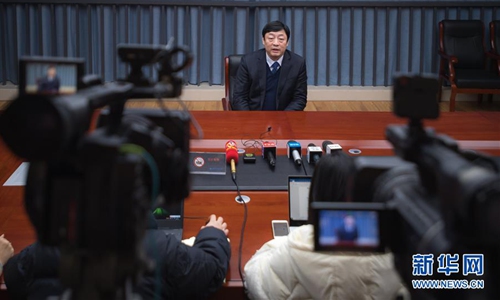HOME >> OPINION,SPECIAL-COVERAGE
Prevent novel virus for auspicious festival
Source:Global Times Published: 2020/1/19 20:58:43

Li Gang, director of Wuhan Center for Disease Control and Prevention, says during a press conference on Sunday that the epidemic in Wuhan can be prevented and controlled. Photo: Xinhua
Of the 62 identified cases of a new form of viral pneumonia that broke out in Wuhan, Central China's Hubei Province, two people died. And 681 of the 763 people who had close contacts with those diagnosed with the pneumonia have been released, with only 82 still under medical observation.Wuhan Center for Disease Control and Prevention said during a press conference on Sunday that they had not ruled out the possibility of limited human-to-human transmission, but the risk of continued human-to-human transmission was low. The center also believes the pneumonia is preventable and controllable.
Confirmed cases of infection with the new coronavirus have been found in Thailand and Japan. There have been suspected cases in Vietnam and Singapore, and 90 suspected cases have been reported in China's Hong Kong Special Administrative Region.
Some analysts believe there may be people who are infected but have not been discovered or confirmed in other parts of the Chinese mainland.
The pneumonia in Wuhan reminds many people of the SARS outbreak in 2003. There has not been a public panic like during SARS. This is probably because the pneumonia has not spread as seriously as SARS and its fatality rate is not as high.
But the source and the transmission route of the new pneumonia in Wuhan are still uncertain. Research into the new coronavirus is still limited. Thus, it is a somewhat mysterious epidemic, which is the biggest reason why people are worried.
The Spring Festival is coming and the movement of people on the Chinese mainland will peak. Preventing the spread of the pneumonia will also face a test. The entire Chinese society should be vigilant but should not be in panic. We should make the upcoming Spring Festival happy and peaceful, and also pay close attention to every link where the pneumonia may increase transmission.
Local disease control centers, medical systems and governments are the main forces in preventing and controlling the spread of the pneumonia. First, we must put in more effort to discover new cases and resolutely put suspected cases into medical observation. Meanwhile, all relevant information must be notified to the public, and there must be no concealment. Concealment would be a serious blow to the government's credibility and might trigger greater social panic.
In the early moments of SARS, there was concealment in China. This must not be repeated.
The new epidemic in Wuhan is not as horrible as SARS. We sincerely hope Chinese society can be more successful in preventing and controlling the pneumonia, and move a big step forward in terms of medicine, social management and public opinion compared with 2003.
This is a test of the effectiveness of the country's disease control mechanisms. We should strengthen the diagnosis and observation of suspected cases and prevent the epidemic from spreading to other places. We must resolutely implement the necessary isolation and release the relevant information, as this can enhance the society's confidence.
International public opinion is increasingly interested in novel pneumonia and foreign speculative information will spread to China. However, the most authoritative force for researching the new pneumonia is in China. As long as relevant parties disclose all information in a timely and comprehensive manner, they can prevent the one-sided quotation of external online information from misleading the Chinese mainland.
Posted in: EDITORIAL